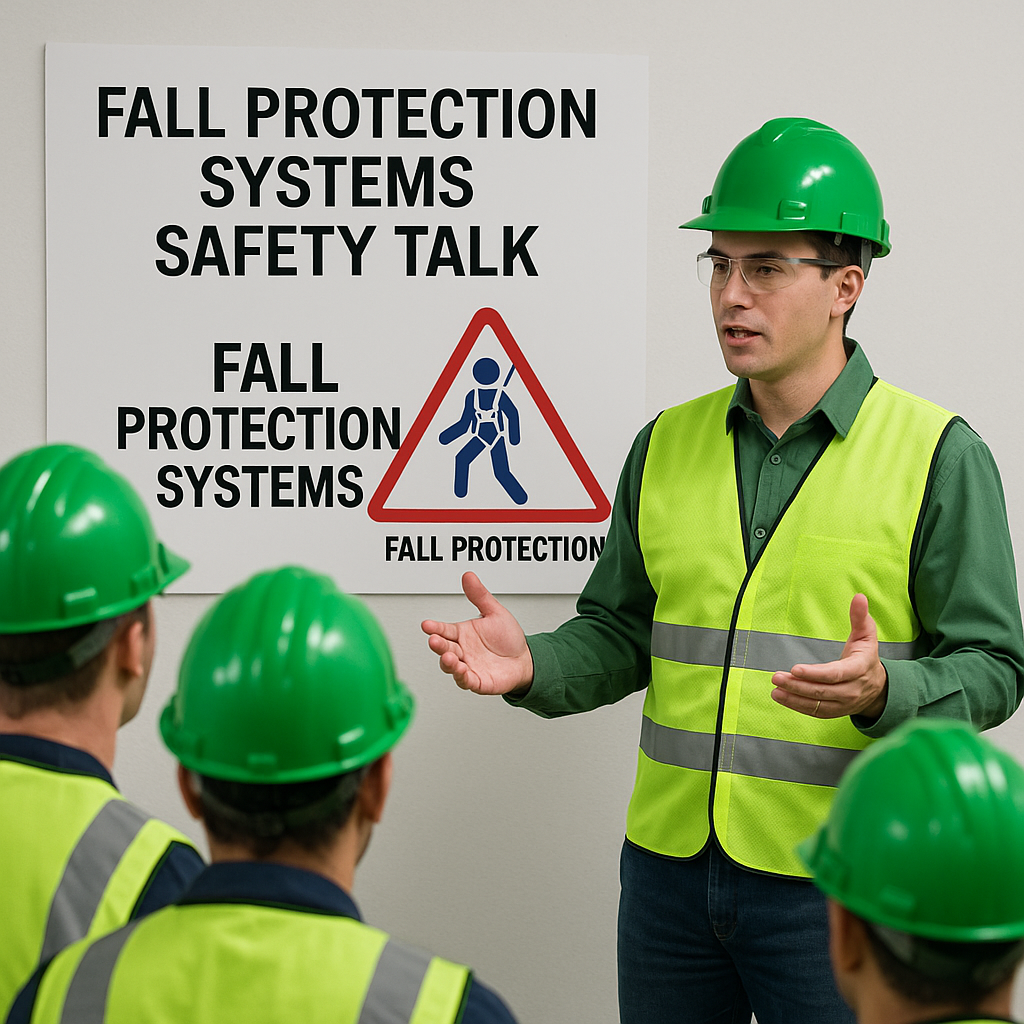
Fall Protection Systems Safety Talk
Role: Safety Officer
Duration: ~10–12 minutes
Audience: Site Workers, Supervisors, Engineers
Format: Toolbox Talk / Safety Induction
1. Greeting & Introduction
“Good morning team,
Let’s begin today’s toolbox talk with a very important topic that directly impacts our safety on site — Fall Protection Systems.
Falls are among the leading causes of serious work-related injuries and deaths, especially in construction and maintenance jobs. So, today, we’re going to understand how to protect ourselves using proper fall protection systems.”
2. Objective of the Talk
“By the end of this session, you should be able to:
- Understand different types of fall protection systems
- Know when and how to use them
- Identify hazards associated with working at heights
- Take necessary steps to prevent falls and save lives”
3. Why Fall Protection Matters
“Here’s a reality check:
A fall from just 6 feet can be fatal. Many of these accidents happen because:
- Workers didn’t use fall protection
- Equipment was faulty
- Or it wasn’t worn or anchored properly
We must treat every elevated work surface — whether it’s a scaffold, ladder, or roof edge — as a potential fall hazard.”
4. Types of Fall Protection Systems
Let’s break them down into 5 key categories:
a) Guardrail Systems
- Permanent or temporary barriers
- Installed along edges to prevent falls
- Should be 42 inches high with a midrail at 21 inches
- Must withstand a 90kg force
b) Personal Fall Arrest Systems (PFAS)
- Includes a full-body harness, lanyard, shock absorber, and anchorage point
- Designed to stop a fall after it has occurred
- Anchor points must support at least 5,000 lbs (about 2,268 kg)
- Must ensure there’s enough fall clearance below the working surface
c) Positioning Systems
- Allows a worker to be supported on a vertical surface (e.g., wall or column)
- Keeps hands free for work
d) Fall Restraint Systems
- Prevents the worker from reaching the fall hazard
- Acts like a leash — keeps you away from the edge
e) Safety Nets
- Used when other systems aren’t feasible
- Installed below the work area
- Must not sag and must be tested for debris or damage regularly
5. Common Fall Hazards
“Fall hazards exist in many areas such as:
- Roof edges
- Unprotected scaffolds or lifts
- Openings in floors or walls
- Ladders not tied off or properly used
- Weather-related slip surfaces (wet, windy, icy)
- Improper use or absence of harnesses
Most fall-related injuries are preventable with awareness and discipline.”
6. Safe Practices for Working at Heights
“Follow these golden rules:
- Inspect equipment before each use (harnesses, lanyards, anchors)
- Always tie-off before you start working
- Ensure the harness fits snugly and is not loose
- Never tie off to guardrails, scaffolding, or random pipes
- Use double lanyards when transferring positions
- Keep working areas free from debris or trip hazards
- Use tool lanyards to prevent dropped objects
- NEVER work alone at heights — always have someone in sight
Also, take weather conditions seriously — strong wind, rain, or lightning can make working at heights extremely dangerous.”
7. Equipment Inspection Checklist
“As a rule of thumb, inspect your personal fall arrest system before every use:
- Look for frayed, cut, or burned straps
- Check metal buckles and D-rings for cracks or rust
- Verify shock absorbers are not deployed
- Tag and report any defective equipment — do not use!”
8. What to Do in Case of a Fall
“In case a fall occurs and the system engages:
- Alert the site supervisor or emergency team immediately
- Do not move the fallen worker unless absolutely necessary
- Use a rescue plan — suspension trauma can occur within 15 minutes
- Have trained personnel perform the rescue operation”
9. Your Responsibility
“As a worker:
- Wear your PPE — always!
- Follow procedures and don’t take shortcuts
- Ask questions if you’re unsure about anchorage or usage
- Report unsafe conditions immediately
Remember, a fall can happen in seconds — but the injury can last a lifetime.”
10. Final Reminders
“To summarize:
- Use the right fall protection system for the job
- Inspect your equipment every single time
- Never bypass safety — even for 5-minute tasks
- Plan your work — fall protection is part of your job planning
If we all stay alert and disciplined, we can ensure that everyone goes home safe at the end of the day.”
11. Open Floor for Questions
“Any questions or situations you’ve faced recently regarding fall protection?
Feel free to speak up — there’s no such thing as a silly question when it comes to safety.”
[Allow workers to share experiences or questions.]
12. Conclusion
“Thank you for your attention and your commitment to safety.
Let’s stay secure, work smart, and never compromise on fall protection.
Remember — your life is worth more than any shortcut.”
100 Safety Topics for Daily Toolbox Talk PDF
130+ Safety Talks and Toolbox Talk Meeting Topics
5 Minute Safety Talk on Work at Height